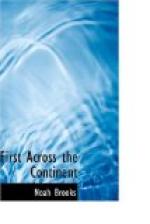The articles reached Mr. Jefferson safely and were long on view at his Virginia residence, Monticello. They were subsequently dispersed, and some found their way to Peale’s Museum, Philadelphia. Dr. Cones, the zealous editor of the latest and fullest edition of Lewis and Clark’s narrative, says that some of the specimens of natural history were probably extant in 1893.
Chapter VII — From Fort Mandan to the Yellowstone
Up to this time, the expedition had passed through regions from which vague reports had been brought by the few white men who, as hunters and trappers in pursuit of fur-bearing game, had dared to venture into these trackless wildernesses. Now they were to launch out into the mysterious unknown, from which absolutely no tidings had ever been brought by white men. The dim reports of Indians who had hunted through some parts of the region were unreliable, and, as they afterwards proved, were often as absurdly false as if they had been fairy tales.
Here, too, they parted from some of their comrades who were to return to “the United States,” as the explorers fondly termed their native country, although the strange lands through which they were voyaging were now a part of the American Republic. The despatches sent to Washington by these men contained the first official report from Lewis and Clark since their departure from St. Louis, May 16, 1803; and they were the last word from the explorers until their return in September, 1806. During all that long interval, the adventurers were not heard of in the States. No wonder that croakers declared that the little party had been cut off to perish miserably in the pathless woods that cover the heart of the continent.
But they set out on the long journey with light hearts. In his journal, whose spelling and punctuation are not always models for the faithful imitation of school-boys, Captain Lewis set down this observation:—




